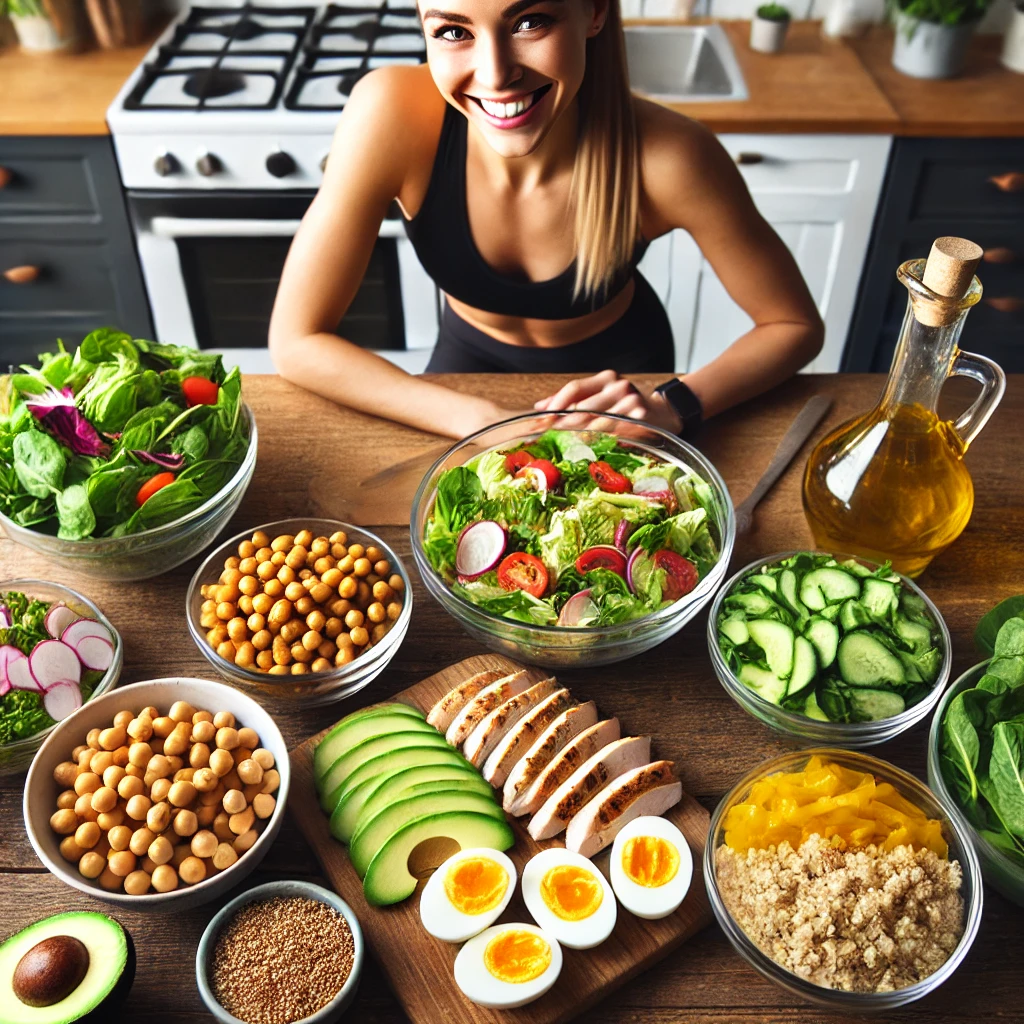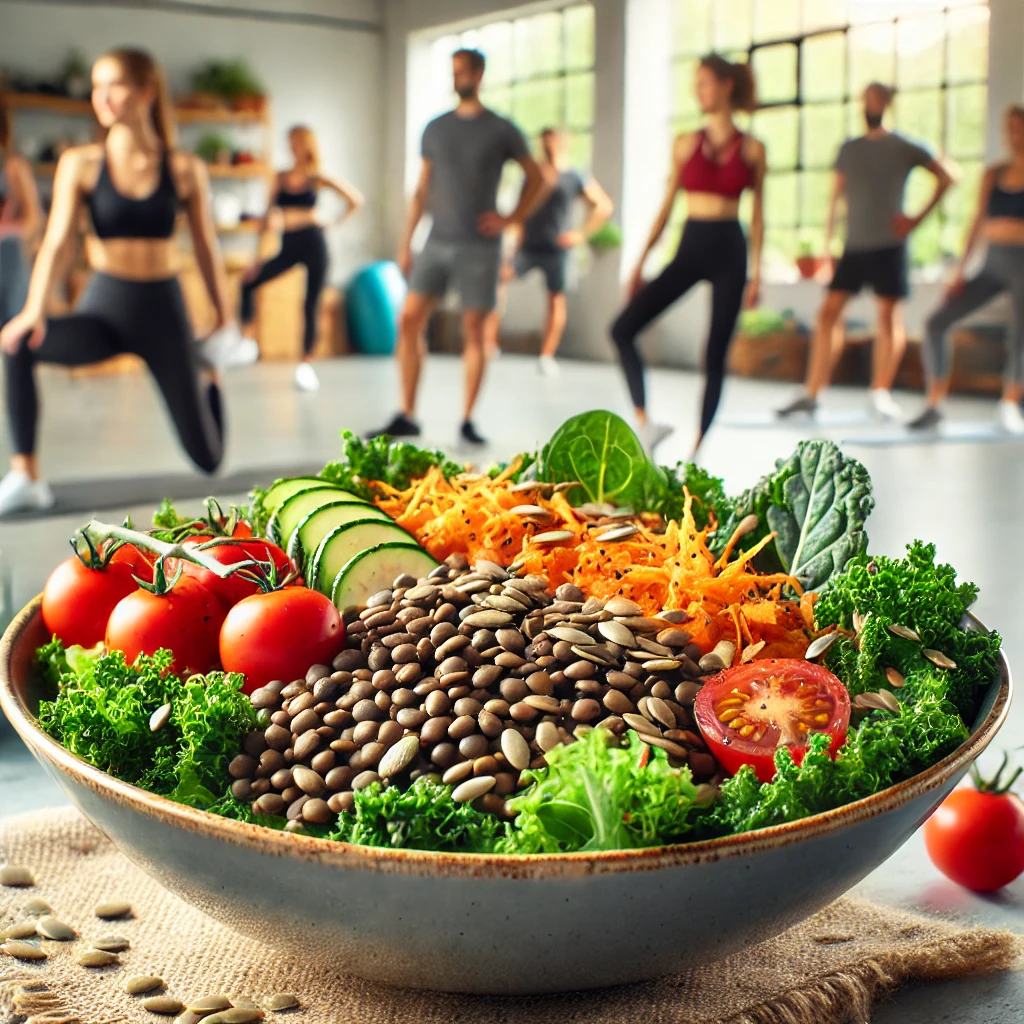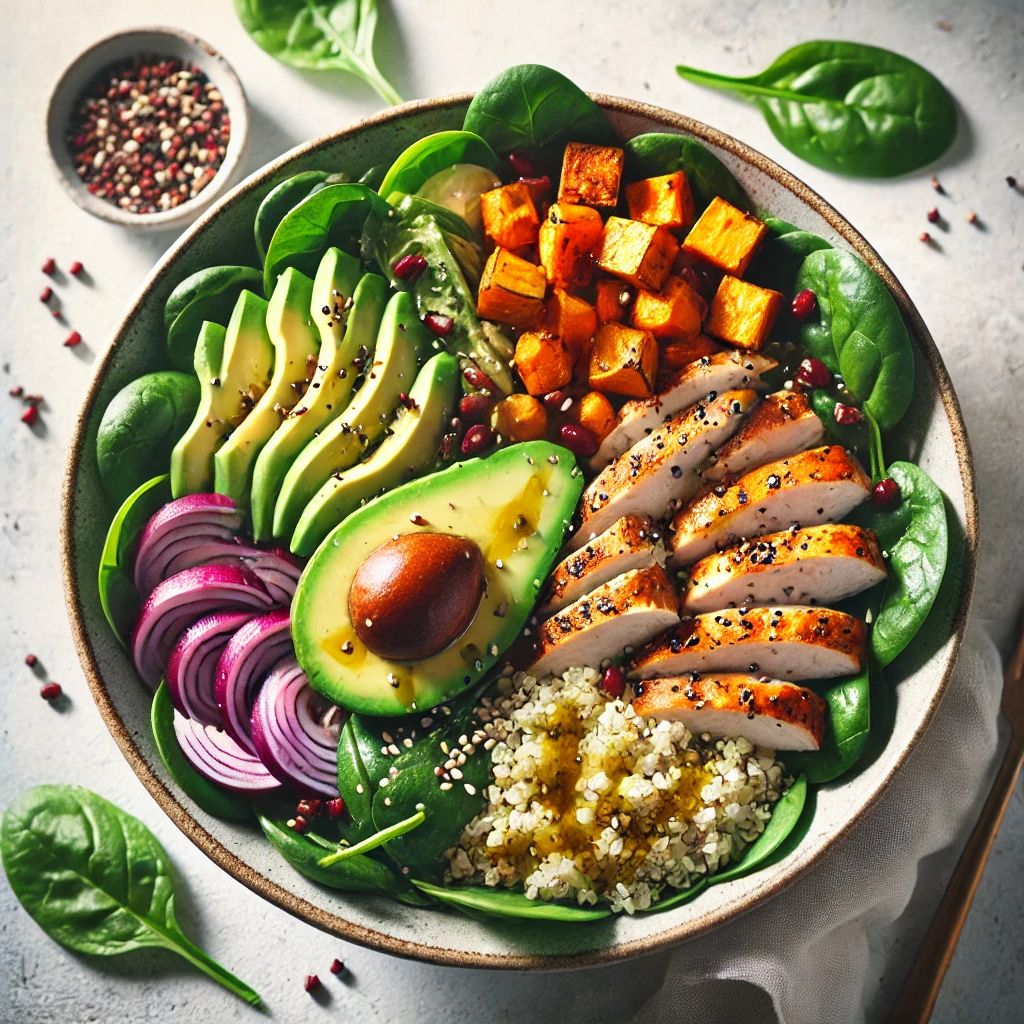Introduction: Transform Your Post-Workout Routine with Recovery Salads
Imagine this: you’ve just completed an intense workout. Your muscles are pleasantly fatigued, endorphins are coursing through your veins, and there’s a triumphant smile on your face. But as the adrenaline subsides, a crucial question arises: what’s the best way to nourish your body to ensure optimal recovery and keep those fitness goals within reach?
This is where post-workout recovery salads come into play—a delightful and effective solution for replenishing your energy and aiding muscle repair. Unlike the typical sugary shakes or processed snacks, these nutrient-dense salads offer a harmonious blend of protein-rich ingredients, wholesome carbohydrates, and fresh, vibrant vegetables. They are thoughtfully crafted to provide everything your body craves after exertion, making them an ideal choice for a healthy post-workout meal.
Consider the versatility of these salads: whether you’re craving a high-protein salad to support muscle synthesis or seeking post-gym nutrition recipes that are both satisfying and beneficial, there’s a myriad of options to explore. From grilled chicken and quinoa bowls to chickpea and avocado medleys, each recipe is designed to cater to your taste buds while delivering essential nutrients.
Incorporating fitness recovery salads into your routine not only enhances your dietary regimen but also adds a refreshing and enjoyable element to your meals. They empower you to take control of your nutrition, ensuring that your post-workout food choices are as dedicated to your well-being as your workouts are.
So, let’s embark on this culinary journey and discover how these delectable salads can become your go-to muscle recovery meals, helping you achieve your fitness aspirations while delighting your palate.
Table of Contents

Why Post-Workout Nutrition Is Essential
After completing a workout, your body embarks on a remarkable journey of recovery and rejuvenation. This phase is crucial, as it’s when your muscles repair, energy stores are replenished, and hydration levels are restored. Let’s delve into the science behind this process and understand how proper nutrition plays a pivotal role.
The Science of Recovery
Engaging in physical exercise, especially of moderate to high intensity, leads to microscopic tears in muscle fibers and the depletion of glycogen—the primary fuel source stored in your muscles. Additionally, substantial fluid loss occurs through sweat. To facilitate effective recovery, your body requires a balanced intake of specific nutrients:
- Protein: Often hailed as the building block of muscles, protein provides essential amino acids necessary for repairing and rebuilding muscle tissue. Consuming adequate protein post-exercise not only aids in muscle repair but also promotes growth, helping you achieve your fitness goals.
- Carbohydrates: During exercise, especially endurance activities, your body taps into glycogen stores for energy. Post-workout, it’s essential to replenish these stores by consuming carbohydrates. This replenishment restores energy levels and prepares your body for future physical activity.
- Hydration: Sweating leads to the loss of fluids and electrolytes, making rehydration a critical component of recovery. Proper hydration supports various bodily functions, including nutrient transport and temperature regulation, ensuring that recovery processes operate smoothly.
Timing Matters
The concept of the “anabolic window” suggests that there’s an optimal period post-exercise during which nutrient intake can significantly enhance recovery. Traditionally, this window was believed to be within 45 minutes after exercise. However, recent research indicates that this window may be more flexible than previously thought. While consuming a balanced meal containing protein and carbohydrates soon after exercise is beneficial, the exact timing can vary based on individual factors such as the intensity of the workout and overall daily nutrition.
Practical Takeaways
- Prioritize Nutrient Intake: Aim to consume a meal rich in protein and carbohydrates after your workout to support muscle repair and glycogen replenishment.
- Stay Hydrated: Monitor your fluid intake, ensuring you replace the fluids lost during exercise. Including electrolytes can be beneficial, especially after intense or prolonged workouts.
- Listen to Your Body: Individual needs can vary. Pay attention to how your body responds to different post-workout nutrition strategies and adjust accordingly.
By understanding and implementing these recovery principles, you can enhance your post-exercise recuperation, leading to improved performance and overall well-being.
Why Salads Are Perfect Post-Workout Meals
While protein shakes and bars offer convenience, they often lack the variety and wholesomeness of a well-prepared salad. Crafting protein-rich salads not only satisfies your taste buds but also provides a balanced array of nutrients essential for post-exercise recovery.
Protein-Packed Ingredients: Incorporate options like grilled chicken, lentils, or tofu to supply essential amino acids necessary for muscle repair and growth. These proteins not only aid in recovery but also keep you feeling full and satisfied.
Complex Carbohydrates: Add quinoa, sweet potatoes, or whole grains to replenish glycogen stores depleted during exercise. These complex carbs provide sustained energy, helping you stay energized throughout the day.
Leafy Greens and Colorful Vegetables: Include spinach, kale, bell peppers, and tomatoes to infuse your salad with antioxidants that combat exercise-induced oxidative stress. These vibrant veggies not only enhance the visual appeal of your meal but also contribute to overall health and vitality.
Healthy Fats: Incorporate avocados, nuts, seeds, or a drizzle of olive oil to reduce inflammation and aid in the absorption of fat-soluble vitamins. These healthy fats add a satisfying richness to your salad, making it both nourishing and delicious.
By thoughtfully combining these components, a high-protein salad becomes more than just a meal—it transforms into a personalized experience that supports muscle recovery, replenishes energy, and delights your palate. Embracing the creativity and customization of salad preparation allows you to enjoy a nutrient-dense, satisfying dish that aligns perfectly with your post-exercise needs.

What Makes the Best Post-Workout Recovery Salads?
The Ideal Nutrient Balance
A great recovery salad is built on three pillars: protein, carbohydrates, and fats. Here’s how each contributes:
- High-Protein Recovery Salads: Include ingredients like chicken, eggs, or tofu to provide essential amino acids for muscle repair.
- Carbohydrate-Rich Ingredients: Foods like sweet potatoes, quinoa, or whole grains replenish glycogen stores.
- Healthy Fats for Recovery: Avocado, nuts, or extra virgin olive oil reduce inflammation and keep you full.
Customizable for Every Goal
Whether your goal is muscle building, weight loss, or simply staying energized, a salad can fit the bill. For example:
- For muscle recovery: Opt for protein-rich options with grilled meats or legumes.
- For weight loss: Focus on low-calorie, high-fiber ingredients like spinach and cucumbers.
How to Build the Perfect Post-Workout Recovery Salad
Step 1: Start with Leafy Greens for Muscle Recovery
Base your salad with nutrient-rich greens like spinach, kale, or arugula. These provide:
- Vitamins A, C, and K for immune support.
- Magnesium and iron for energy production and muscle repair.
Step 2: Add a Protein Powerhouse
Protein is non-negotiable in any post-workout meal. Great options include:
- Grilled chicken or turkey for lean protein.
- Boiled eggs for convenience and nutrient density.
- Plant-based proteins like chickpeas or lentils for vegan-friendly options.
Step 3: Incorporate Carbohydrates for Glycogen Replenishment
Carbs are your energy-boosting secret. Add:
- Quinoa or roasted sweet potatoes for complex carbs.
- Fruits like blueberries or apples for a touch of natural sweetness.
Step 4: Don’t Skip Healthy Fats
Healthy fats reduce inflammation and improve nutrient absorption. Try:
- Avocado slices for creaminess.
- A handful of nuts or seeds for crunch.
Step 5: Top with Antioxidant-Rich Ingredients
Add colorful vegetables like cherry tomatoes, yellow peppers, or cucumbers to fight oxidative stress. Sprinkle superfoods like chia seeds or hemp hearts for extra nutrients.

5 Must-Try Post-Workout Salad Recipes
- High-Protein Chicken and Quinoa Salad
- Ingredients: Grilled chicken, quinoa, spinach, roasted sweet potatoes, and lemon-tahini dressing.
- Why it works: A perfect combination of protein and carbs for muscle repair and energy.
- Vegan Power Bowl with Lentils and Kale
- Ingredients: Lentils, kale, carrots, sunflower seeds, and balsamic vinaigrette.
- Why it works: Plant-based protein and antioxidants make this ideal for recovery.
- Omega-3 Salmon and Spinach Salad
- Ingredients: Grilled salmon, spinach, avocado, and dill-yogurt dressing.
- Why it works: Combines protein and anti-inflammatory omega-3s.
- Sweet Potato and Chickpea Salad
- Ingredients: Roasted sweet potatoes, chickpeas, baby spinach, and paprika dressing.
- Why it works: Energizing carbs paired with plant-based protein.
- Hydrating Watermelon and Cucumber Salad
- Ingredients: Watermelon, cucumber, feta cheese, mint, and lime-honey dressing.
- Why it works: Hydrates and refreshes after a summer workout.
Common Mistakes to Avoid in Post-Workout Recovery Salads
Making post-workout recovery salads is one of the smartest ways to refuel after exercise, but even with the best intentions, it’s easy to make mistakes that limit their effectiveness. By avoiding these common pitfalls, you can ensure your salad is truly optimized for post-workout nutrition and helps you recover faster, rebuild stronger, and feel your best.
1. Skipping Protein: Your Muscles Need It
Protein is the most important ingredient in any post-workout recovery salads. After exercise, your muscles need amino acids to repair the tiny tears caused by your workout and build new muscle tissue. Without enough protein in your post-workout meal, recovery slows, muscle soreness lasts longer, and you may miss out on progress.
Make protein a priority by including options like grilled chicken, turkey, salmon, hard-boiled eggs, or plant-based choices like tofu, edamame, lentils, or chickpeas. Don’t forget extras like cottage cheese or Greek yogurt for a protein boost. Ideally, aim for 20–30 grams of protein in your salad to meet your recovery needs.
Pro Tip: Meal prep protein ahead of time by grilling chicken or roasting chickpeas in batches so it’s ready to toss into your salad when you need it.
2. Overloading on Fats: Keep It Balanced
Healthy fats like avocado, olive oil, nuts, and seeds are great additions to nutrient-dense salads, as they reduce inflammation and improve nutrient absorption. However, overloading on fats can slow digestion, which means your body won’t absorb the nutrients from your salad as quickly as it should after a workout.
Stick to balanced portions. Use a quarter to half an avocado, a tablespoon of olive oil, or a small handful of nuts or seeds in your salad. If you’re adding multiple sources of fat, scale back the quantities of each so you don’t overdo it. The key is balance—enough fat to nourish your body without delaying recovery.
Pro Tip: Mix healthy fats with proteins, like a handful of almonds paired with grilled chicken or olive oil drizzled over salmon, for a well-rounded recovery meal.
3. Using Sugary Dressings: Skip the Hidden Sugar Bombs
A healthy post-workout recovery salad can quickly turn unhealthy if topped with a sugary, store-bought dressing. Many packaged dressings are loaded with added sugars, unhealthy oils, and artificial ingredients that can undermine your recovery and even cause energy crashes.
Instead, choose natural, homemade dressings made with clean ingredients. Simple combinations like olive oil and balsamic vinegar, lemon-tahini, or Greek yogurt-based dressings are excellent choices. They enhance your salad’s flavor without the unnecessary sugar or additives. Plus, yogurt-based dressings add an extra protein boost, making them ideal for post-workout meals.
Pro Tip: If you buy a store-bought dressing, check the label for added sugars (aim for less than 2 grams per serving) and avoid ingredients like high-fructose corn syrup or hydrogenated oils.
4. Forgetting Carbs: Don’t Skip Your Energy Source
Many people forget to include carbs in their post-workout meal, but they’re essential for replenishing glycogen stores—the body’s primary energy source. Skipping carbs can leave you feeling sluggish, tired, and under-recovered, especially after high-intensity workouts.
Incorporate healthy, complex carbs into your post-workout recovery salads. Add options like quinoa, farro, sweet potatoes, roasted butternut squash, or brown rice to provide sustained energy without a blood sugar spike. A half-cup of cooked quinoa or a small roasted sweet potato is enough to restore energy and support recovery.
Pro Tip: For extra flavor and texture, mix roasted vegetables like sweet potatoes or squash with your greens to create a warm, hearty post-workout salad.
5. Sticking to the Same Ingredients: Add Variety for Better Nutrition
While it’s tempting to stick to the same salad recipe, repeating the same ingredients day after day can lead to boredom and limit your nutrient intake. Variety in your nutrient-dense salads ensures you’re getting a wide range of vitamins, minerals, and antioxidants to support full recovery. For example, rotating leafy greens like spinach, kale, arugula, or Swiss chard keeps things fresh and provides different health benefits.
Switch up your proteins, toppings, and seasonal produce. For instance, in the summer, incorporate hydrating ingredients like cucumbers and watermelon, while in the fall or winter, focus on hearty roasted veggies like sweet potatoes or beets. Seasonal ingredients not only taste better but are often more nutrient-dense.
Pro Tip: Challenge yourself to try one new ingredient each week, like roasted chickpeas, hemp seeds, or citrus fruits, to keep your salads exciting and nutrient-packed.
By avoiding these common mistakes, you can make sure your post-workout recovery salads are working as hard as you do. Focus on including enough protein, balancing your fats, choosing clean dressings, replenishing carbs, and rotating ingredients to keep things fresh and nutritious. With these strategies, your salads will be the perfect tool to refuel, rebuild, and recharge your body after every workout.
3 Quick Tips for Creating the Perfect Recovery Salad
Prep Ahead: Save Time and Boost Convenience
When it comes to crafting the perfect post-workout recovery salads, preparation is key. Save time during the week by setting aside a day to pre-cook your proteins like grilled chicken, baked salmon, or roasted chickpeas. Store them in airtight containers to keep them fresh and ready to toss into your salads. Similarly, chop a variety of colorful veggies—like bell peppers, cucumbers, carrots, or leafy greens—and store them in separate containers for easy access. For an added nutritional boost, consider prepping whole grains like quinoa, farro, or barley, which provide slow-digesting carbs to replenish your energy stores.
Additionally, keep salad bases like spinach, kale, or mixed greens washed and ready to go. If you’re someone who craves variety, try making small batches of different homemade dressings—such as lemon-tahini, balsamic vinaigrette, or Greek yogurt-based ranch. This way, you can switch up the flavors of your salads throughout the week while still sticking to your recovery goals.
Experiment with Flavors: Elevate Your Salad Game
A great post-workout recovery salad doesn’t just refuel your body—it excites your taste buds, too! Experimenting with flavors can keep you motivated to prioritize healthy eating. Try adding a handful of fresh herbs like cilantro, parsley, mint, or basil to your salad for a fragrant and flavorful punch. Spices like smoked paprika, cumin, turmeric, or chili flakes not only enhance taste but also come with added health benefits—such as reducing inflammation and boosting metabolism.
Don’t shy away from using citrus fruits like oranges, lemons, or grapefruits to add brightness and balance to your salad. The natural acidity not only elevates the flavor but also enhances the absorption of nutrients like iron from leafy greens. To tie everything together, a splash of freshly squeezed lime or lemon juice over your salad can provide a zesty finish that complements your ingredients perfectly.
Seasonal Ingredients: Maximize Nutrition and Freshness
Selecting seasonal produce is one of the easiest ways to ensure your post-workout recovery salads are packed with maximum flavor and nutrients. Seasonal ingredients are often fresher, more nutrient-dense, and cost-effective. For example, in the summer, opt for hydrating veggies like cucumbers, zucchini, and tomatoes, paired with juicy fruits like watermelon or peaches. These provide essential vitamins and antioxidants to aid recovery and fight post-workout inflammation.
During the colder months, turn to hearty root vegetables like sweet potatoes, beets, and carrots, which are rich in carbohydrates and fiber to replenish glycogen stores and keep you satisfied. Winter greens like kale, Swiss chard, and Brussels sprouts can also pack a nutrient punch, offering vital minerals like potassium and magnesium that aid in muscle recovery.
Finally, consider adding nuts, seeds, or seasonal berries for added texture and nutrients. For instance, pumpkin seeds in the fall provide zinc for immune support, while pomegranate seeds in winter bring a sweet, tangy crunch and are packed with antioxidants to reduce muscle soreness.
By focusing on prepping ahead, experimenting with flavors, and incorporating seasonal ingredients, you can make every post-workout recovery salads a powerful, delicious tool in your fitness and wellness journey. Not only will these strategies save you time, but they’ll also ensure you’re nourishing your body with meals that are fresh, flavorful, and optimized for recovery.
What are the best ingredients to include in post-workout recovery salads for optimal muscle recovery and energy replenishment?
The best ingredients for post-workout recovery salads are those that provide a balanced mix of protein, healthy fats, complex carbohydrates, and essential vitamins and minerals to support muscle repair and energy restoration. Here’s what to include:
- Protein Powerhouses: Opt for lean proteins like grilled chicken, turkey, hard-boiled eggs, baked salmon, tofu, or plant-based options like roasted chickpeas or black beans. These ingredients are essential for muscle repair and growth.
- Complex Carbs: Add quinoa, farro, sweet potatoes, or brown rice to replenish glycogen stores and provide sustainable energy after your workout.
- Leafy Greens: Use a base of nutrient-rich greens like spinach, kale, arugula, or mixed greens. These are packed with vitamins A, C, and K, which aid in reducing inflammation and promoting recovery.
- Healthy Fats: Include avocado, olive oil-based dressings, nuts (like almonds or walnuts), or seeds (like chia, flax, or sunflower seeds). Healthy fats help reduce muscle inflammation and improve nutrient absorption.
- Antioxidant Boosters: Incorporate antioxidant-rich ingredients like berries, pomegranate seeds, cherry tomatoes, or bell peppers to combat oxidative stress caused by exercise.
- Hydrating Veggies: Add cucumbers, zucchini, or celery to help rehydrate your body post-workout.
- Flavor Enhancers: Fresh herbs like cilantro, parsley, or basil, as well as citrus fruits like oranges or grapefruit, add brightness to your salad while providing additional nutrients.
By combining these ingredients, you’ll create a nutrient-dense salad that not only tastes amazing but also delivers the nutrition your body needs to recover efficiently and prepare for your next workout.
How do post-workout recovery salads compare to traditional post-workout meals in supporting fitness goals and overall nutrition?
Post-workout recovery salads are an excellent alternative to traditional post-workout meals because they are lighter, customizable, and packed with fresh, nutrient-dense ingredients. Here’s how they compare:
- Nutrient Density: Recovery salads are loaded with vitamins, minerals, and antioxidants from fresh vegetables, leafy greens, and fruits. Traditional post-workout meals like sandwiches or protein shakes may focus on macros but often lack the micronutrient variety found in salads.
- Digestibility: After a workout, your body might not feel ready for heavy meals. Recovery salads are easier to digest and less likely to leave you feeling weighed down, making them perfect for quick recovery.
- Customization: Salads are incredibly versatile. You can easily adjust the ingredients to match your fitness goals, whether you’re looking to build muscle (by increasing protein) or restore energy (by adding more carbs). Traditional meals are often less flexible in this regard.
- Reduced Inflammation: Thanks to their inclusion of fresh vegetables, fruits, and healthy fats, post-workout salads help combat inflammation and muscle soreness more effectively than many processed or carb-heavy meals.
- Hydration Support: Many salad ingredients, like cucumbers, tomatoes, and leafy greens, have a high water content, which supports rehydration after sweating. Traditional meals may not address hydration as effectively.
That said, both post-workout recovery salads and traditional meals have their place, depending on your needs. Salads are ideal if you’re looking for a clean, fresh, and nutrient-dense post-workout meal, while heavier meals may be better suited for those with higher calorie requirements or more intense recovery needs.
Incorporating post-workout recovery salads into your routine is a smart way to support fitness goals while enjoying a flavorful, balanced, and health-focused meal!
Conclusion: Thrive with Post-Workout Recovery Salads
Your fitness journey doesn’t end when your workout is over—it’s just the beginning of how you rebuild, refuel, and recharge your body. That’s where post-workout recovery salads come in. Packed with the nutrients your body craves, these salads are a simple, delicious way to support your recovery and take your fitness to the next level.
Think beyond boring or processed post-workout snacks. Instead, imagine a vibrant, protein-rich salad filled with grilled chicken, creamy avocado, crunchy nuts, and a drizzle of fresh lemon dressing. Or an energizing bowl loaded with leafy greens, quinoa, and antioxidant-rich fruits like berries or pomegranate. These nutrient-dense salads are specifically designed to help replenish your energy, repair muscles, and reduce inflammation after every workout.
Choosing a wholesome post-workout meal like a recovery salad isn’t just about eating healthy—it’s about feeling stronger, more energized, and ready to crush your next workout. By prioritizing post-workout nutrition, you’re giving your body exactly what it needs to recover faster and perform better over time.
So, ditch the quick fixes and fuel your body with the right ingredients. Post-workout recovery salads aren’t just meals—they’re the building blocks of your fitness journey. Refuel, recover, and thrive—because you’re worth it!
FAQs
How soon can you eat after exercising?
After exercising, it’s ideal to eat within 30 to 60 minutes to optimize recovery. Eating within this window helps replenish glycogen stores, repair muscle tissue, and support overall recovery. Eating too soon or too late can hinder the body’s natural recovery processes, so aim for a balanced meal or snack soon after your workout.
Is eating 30 minutes post-workout beneficial?
Yes, eating within 30 minutes after working out is beneficial, especially if you’re looking to optimize muscle recovery. This time frame allows your body to absorb nutrients quickly, replenishing glycogen stores and starting the muscle repair process. A mix of protein and carbs is key during this period for maximum benefit.
Which foods should be avoided after a workout?
After exercising, you should avoid foods high in unhealthy fats, excess sugar, or overly processed items. These foods can slow down the recovery process and may contribute to inflammation or fatigue. Instead, focus on whole foods like lean proteins, healthy fats, and complex carbohydrates for better recovery.
Are there times when you should skip eating post-workout?
Generally, it’s recommended to eat after a workout, but there may be times when you don’t need to immediately consume a meal. If your workout was light or if you’ve recently eaten, your body might not need immediate refueling. However, for intense workouts or those focused on muscle building, post-workout nutrition is crucial for recovery.
Is it effective to eat right after a workout for muscle gain?
Yes, eating immediately after a workout can enhance muscle growth. Your muscles are more receptive to nutrients in the first 30 minutes to an hour post-exercise, allowing your body to repair and rebuild muscle tissue. Consuming protein and carbs right after helps stimulate muscle protein synthesis and replenish energy stores.
Why is it crucial to eat after exercise?
Eating after exercise is crucial because it helps your body recover, repair muscles, and restore energy levels. During a workout, your muscles use up glycogen stores and undergo microscopic damage. Post-workout nutrition helps to rebuild muscle fibers, replenish glycogen, and prevent muscle breakdown, leading to better performance in your next session.
How do balanced meals help in recovery after exercise?
Balanced post-workout meals that include protein, carbs, and healthy fats play a crucial role in muscle recovery. Protein helps rebuild muscle fibers, carbs replenish glycogen stores, and healthy fats support inflammation reduction. Together, they ensure you recover faster, feel less fatigued, and are ready for your next workout.
What are the best foods for muscle repair?
The best foods for muscle repair include lean proteins like chicken, turkey, or tofu, as well as fish rich in omega-3s such as salmon. Whole grains, leafy greens, and fruits provide the carbohydrates, vitamins, and minerals needed to fuel recovery. Additionally, foods like eggs, quinoa, and Greek yogurt are excellent choices for promoting muscle repair.
What role do nutritious meals play in post-workout recovery?
Nutritious meals play a pivotal role in post-workout recovery by providing essential nutrients that the body needs to heal. These meals supply protein for muscle repair, carbohydrates to replenish glycogen stores, and fats to support inflammation control. Proper nutrition after a workout also helps prevent fatigue and supports long-term performance gains.
How essential is a post-workout meal for recovery?
A post-workout meal is extremely important for recovery as it helps restore energy, promote muscle growth, and enhance overall performance. Without proper nutrition after exercise, the body may take longer to recover, leading to fatigue and muscle soreness. A well-balanced meal ensures that you bounce back quickly and efficiently for your next workout.
Is eating salad after a workout a good idea?
Yes, eating salad after a workout can be a good idea, especially if the salad includes nutrient-dense ingredients like lean protein (chicken, beans), healthy fats (avocado, nuts), and complex carbs (sweet potatoes, quinoa). Salads are hydrating and can help provide the necessary vitamins and minerals to aid in recovery.
Is it beneficial to have salad after exercising?
It can be beneficial to have salad after exercising if you include ingredients that support recovery. A salad filled with leafy greens, protein-rich foods, and a healthy fat source will help replenish glycogen stores and repair muscle tissue. Avoid heavy dressings that may undo some of the health benefits.
Which drinks are best for muscle recovery?
For muscle recovery, drinks like water, coconut water, and sports drinks that contain electrolytes can help hydrate and replenish lost fluids. Additionally, protein shakes with a mix of protein and carbs are a great option for muscle recovery, as they provide the necessary nutrients for muscle repair and energy restoration.
What should be avoided to promote better muscle recovery?
To promote better muscle recovery, avoid sugary drinks, excessive caffeine, alcohol, and highly processed foods. These can hinder recovery by causing dehydration, increasing inflammation, and delaying muscle repair. Focus instead on hydrating with water, consuming nutrient-rich foods, and avoiding unnecessary junk foods that can slow down the recovery process.
Why are post-workout recovery salads effective?
They combine protein, carbs, and healthy fats, providing everything your body needs for recovery.
Can I make post-workout salads in advance?
Absolutely! Prep your ingredients in advance for quick assembly after your workout.
What are the best leafy greens for muscle recovery?
Spinach, kale, and arugula are nutrient-dense and ideal for recovery.
Do salads work for weight loss after exercise?
Yes! Salads with low-calorie, nutrient-dense ingredients can support weight loss.
What’s a quick dressing for a recovery salad?
Try mixing olive oil, lemon juice, Dijon mustard, and honey for a simple, nutritious dressing.
you may also like:
Salad Recipes for Weight Loss: The Ultimate Guide to Healthy Eating and Wellness
Unlock the Benefits of Salad: Nutritional Power for Health, Wellness, and Active Living
High Protein Salad Recipes: The Perfect Fit for Health and Active Lifestyles
Energy-Boosting Salad Recipes: A Complete Guide to Power-Packed Meals
More relevant articles here >>>
More Health and Wellness Salad Recipes >>>
More Energy and Active Lifestyle Salad Recipes >>>
More Cultural and Seasonal Recipes >>>
References:
Nutrient Timing Revisited: Is there a Post-exercise Anabolic Window?
Post-Exercise Glycogen Repletion in Muscle: Does Timing Matter?
Omega-3 Fatty Acids and Exercise: Anti-Inflammatory Potential and Emerging Research









